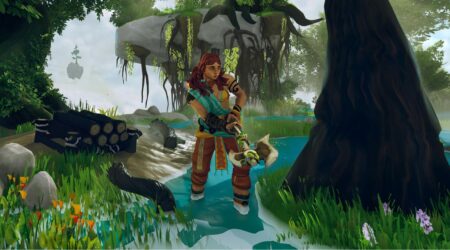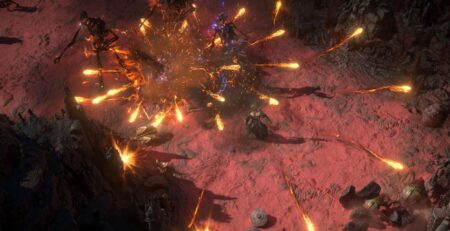Developed by Massive Entertainment and Published by Ubisoft, Avatar: Frontiers of Pandora expands the franchise canonically by bringing players to the Western Frontier, previously unexplored by stories in James Cameron’s sci-fi universe in comics or in Avatar or Avatar: The Way of Water. In doing so, you play as a Sarentu Na’vi, who was kidnapped by the RDA when you were a child. There, you were forcibly assimilated into Sky People culture and kept from connecting with yours. When you’re rescued, you’re tasked to begin reaching out to the clans on the Western Frontier in order to bring them together to fight in a resistance against the RDA. In short, the game is about finding your people and at every step along the way, community first, which, of course, makes Avatar: Frontiers of Pandora co-op a natural fit.
With a high focus on learning about the diverse Na’vi cultures between tribes through the main story and side quests, one thing is clear: the Na’vi are communal. Whether they’re from the Aranahe, Zeswa, or Kame’tire clans, their connection to each other through Eywa and their traditions focuses Avatar: Frontiers of Pandora’s narrative on finding your place in a community. The narrative works solo, but there is something special about playing through the entire main story mission with someone else by your side. Avatar: Frontiers of Pandora offers a co-op experience where each player maintains individuality and shares in exploring a vibrant and lush environment.
First things first, as a player, you can access Avatar: Frontiers of Pandora co-op at around the three-hour mark of the game, depending on how quickly you choose to move through the main storyline or get entirely distracted by exploring the trees like I did. Co-op is locked behind the main story quest, “The Aranahe Clan,” which serves as your first entry into Pandora and reconnecting to your clan. From there, you can play through the rest of the game with another person, and to be honest, it rules. Once you and your friend are at the Aranahe Hometree, you can open up a co-op group and play through the story together.
This is done through Ubisoft Connect and requires the duo to be online—sorry, couch co-op folks. That said, because it’s through Ubisoft Connect, you can run through the adventure on different platforms with full crossplay baked into the co-op option. While both players must be online, the player’s individual settings can be set to whatever challenge they want. Someone can run Exploration and the other Guided as you move through the vast Western Frontier of Pandora, and difficulty settings are also adjustable. The co-op multiplayer mode doesn’t get int he way of how you want to play.
![]()
Still, drop-in-drop-out co-op systems in video games are known for not always being the best for keeping progress in terms of not just quest progression but also the gear you get throughout your time playing. In Avatar: Frontiers of Pandora, the co-op group is hosted by one player, making their version of Pandora the one being changed by the events; the other player is a guest. This means that some quests and missions tied to the host’s progression and version of Pandora are non-transferable. For example, clearing out polluting oil refineries in the host’s game is not reflected in the guest’s version of Pandora. That said, quests completed and gear or items gained while playing with another person are all saved and available when playing solo as well.
Something to mention about confirming your progression is that when a main story quest gives you items, you will get duplicates of those items. Additionally, depending on whether you are present for a leg of the quest you won’t receive that item until after you return to your solo session. However, receiving the items from story progression in the host’s version of Pandora is a good failsafe to ensure that players who miss a leg of the main story don’t lose out on necessary items.
The only caveat is that if a guest doesn’t pick up a side-quest before joining the host’s session, they will not have it when they return to their solo playthrough. You can pick it up again, but a quick and easy workaround to a problem that comes from the nature of drop-in-drop-out is that you need to finish the side quest during your co-op session—or just don’t pick them up. That said, because you maintain fast travel to the main cities explored in co-op, and that is where quests are housed, doubling back to quickly pick up quests isn’t the biggest deal breaker.
![]()
The Avatar: Frontiers of Pandora progression system works well enough. The guest player can choose to keep the completed main story progress once they start playing solo again or to ignore it. That option alone helps give players the autonomy to both have a game they run with a friend and play on their own without restrictions. That said, all of the side quests remain completed in the solo session if they were completed in co-op.
The only issue with this system is that it can lag behind based on how long your co-op session was. In one of the later quests where you’re barred from accessing your map, we chose to end our session to head to dinner. When we came back, the guest player was out in the open, no longer confined but still without access to the map. After a little bit, the game caught up and gave the option to sync the progress, and it was easily remedied.
Outside of some progression hiccups, the server stability for Avatar: Frontiers of Pandora co-op was finely tuned and offered little to no technical issues, even in the review period before release. With as many games that have come out with large glaring technical issues at launch or multiplayer lobbies that didn’t even connect, successful co-op support at launch feels like a rare feat. But Massive accomplished it, allowing players to tackle nearly the entire game with someone else, making the replayability and exploration investment even greater.
When it comes to communicating, the waypoints and the simple ping system are your biggest assets. Even when playing in a voice chat with your co-op partner, the world of Pandora is so vast that it’s easy to get separated or veer off the path, especially calling them to your location when you find something new. The map system allows for one waypoint to be set by each player, both denoted by different colors. Whether setting waypoints to ensure you both end up at the same spot or calling out a Bellsprig you found, the ping system is simplistic, but it gets the job done. It’s especially helpful when you’re moving quickly through the Pandoran wilderness and the RDA facilities, which can be a maze at times.
![]()
To help accommodate the vast scale of the Pandoran frontier, you also have the option to fast travel to your co-op partner’s side if you’re separated and they’re looking to continue the quest. This also comes in handy when you accidentally trigger an animation that isn’t easily undone without both people present. That said, it is slightly frustrating to see “waiting for ally” come up on the screen consistently or ask if you’d like to fast-travel without a clear attachment to a situation at hand.
Communicating during infiltrations is also important. Combat in Avatar: Frontiers of Pandora is simple, and in co-op, you might expect RDA bases to be more easily cleared. While flying through the skies solo is still a stellar experience, getting the chance to take down RDA helicopters and polluting facilities with someone else is unmatched. With much of each area’s leveling is dictated by the score of your gear, you can compensate, usually about two levels higher than you, with someone at your side. However, with each subsequently leveled RDA base having more and more fortifications, it can get dicey.
In truth, once you start taking damage, it’s easy to snowball. The RDA’s metal cuts hard, and once you’re hit, dodging gets substantially harder to sustain. Working through the tough situations of the RDA facilities gets easier with a partner who can help pull enemy fire and revive you when you’re downed.
Ultimately, Avatar: Frontiers of Pandora co-op never feels tacked on or out of place. It keeps cinematic scenes specific to the players’ characters and only suffers some small issues when it comes to consistently progressing. That said, when you’re rallying the Na’vi of the Western Frontier to arms against the colonizing force of the RDA, it feels so much better to do so with someone at your side. The game is focused on reclaiming and embracing community, and the co-op element is a feature that speaks volumes to the story’s narrative goals.
Avatar: The Frontiers of Pandora is available December 7, 2023 on PC, PS5, and Xbox Series X|S.






